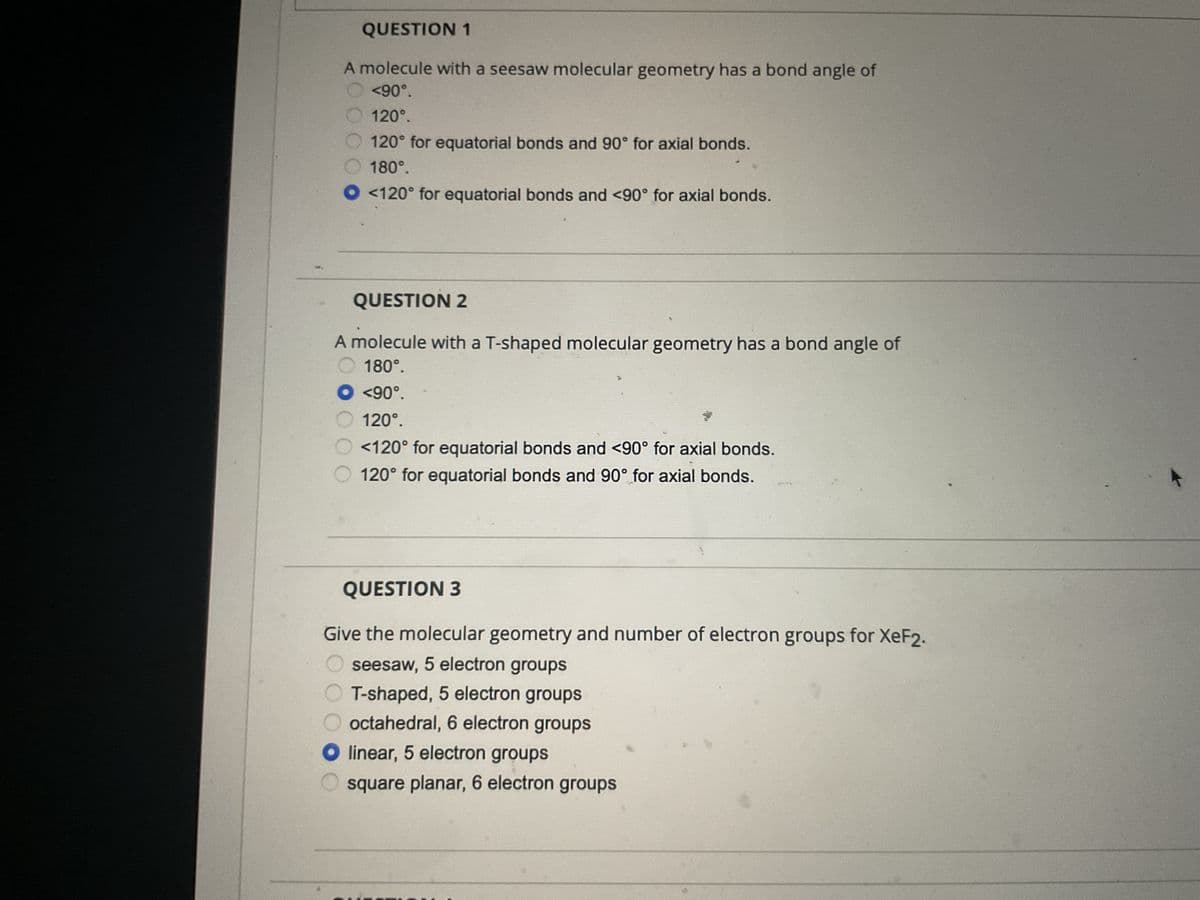QUESTION 1 A molecule with a seesaw molecular geometry has a bond angle of <90°. 120°. 120° for equatorial bonds and 90° for axial bonds. 180°. O <120° for equatorial bonds and <90° for axial bonds. 10000 QUESTION 2 A molecule with a T-shaped molecular geometry has a bond angle of 180°. <90°. 120°. <120° for equatorial bonds and <90° for axial bonds. 120° for equatorial bonds and 90° for axial bonds. QUESTION 3 Give the molecular geometry and number of electron groups for XeF2. seesaw, 5 electron groups T-shaped, 5 electron groups O octahedral, 6 electron groups linear, 5 electron groups square planar, 6 electron groups
QUESTION 1 A molecule with a seesaw molecular geometry has a bond angle of <90°. 120°. 120° for equatorial bonds and 90° for axial bonds. 180°. O <120° for equatorial bonds and <90° for axial bonds. 10000 QUESTION 2 A molecule with a T-shaped molecular geometry has a bond angle of 180°. <90°. 120°. <120° for equatorial bonds and <90° for axial bonds. 120° for equatorial bonds and 90° for axial bonds. QUESTION 3 Give the molecular geometry and number of electron groups for XeF2. seesaw, 5 electron groups T-shaped, 5 electron groups O octahedral, 6 electron groups linear, 5 electron groups square planar, 6 electron groups
Organic Chemistry: A Guided Inquiry
2nd Edition
ISBN:9780618974122
Author:Andrei Straumanis
Publisher:Andrei Straumanis
Chapter4: Polar Bonds, Polar Reactions
Section: Chapter Questions
Problem 10CTQ
Related questions
Question

Transcribed Image Text:QUESTION 1
A molecule with a seesaw molecular geometry has a bond angle of
<90°.
120°.
120° for equatorial bonds and 90° for axial bonds.
180°.
● <120° for equatorial bonds and <90° for axial bonds.
QUESTION 2
A molecule with a T-shaped molecular geometry has a bond angle of
180°.
<90°.
120°.
<120° for equatorial bonds and <90° for axial bonds.
120° for equatorial bonds and 90° for axial bonds.
QUESTION 3
Give the molecular geometry and number of electron groups for XeF2.
seesaw, 5 electron groups
T-shaped, 5 electron groups
octahedral, 6 electron groups
O linear, 5 electron groups
square planar, 6 electron groups
Expert Solution
This question has been solved!
Explore an expertly crafted, step-by-step solution for a thorough understanding of key concepts.
This is a popular solution!
Trending now
This is a popular solution!
Step by step
Solved in 4 steps with 1 images

Knowledge Booster
Learn more about
Need a deep-dive on the concept behind this application? Look no further. Learn more about this topic, chemistry and related others by exploring similar questions and additional content below.Recommended textbooks for you

Organic Chemistry: A Guided Inquiry
Chemistry
ISBN:
9780618974122
Author:
Andrei Straumanis
Publisher:
Cengage Learning

Organic Chemistry
Chemistry
ISBN:
9781305580350
Author:
William H. Brown, Brent L. Iverson, Eric Anslyn, Christopher S. Foote
Publisher:
Cengage Learning


Organic Chemistry: A Guided Inquiry
Chemistry
ISBN:
9780618974122
Author:
Andrei Straumanis
Publisher:
Cengage Learning

Organic Chemistry
Chemistry
ISBN:
9781305580350
Author:
William H. Brown, Brent L. Iverson, Eric Anslyn, Christopher S. Foote
Publisher:
Cengage Learning


Introduction to General, Organic and Biochemistry
Chemistry
ISBN:
9781285869759
Author:
Frederick A. Bettelheim, William H. Brown, Mary K. Campbell, Shawn O. Farrell, Omar Torres
Publisher:
Cengage Learning


Chemistry for Today: General, Organic, and Bioche…
Chemistry
ISBN:
9781305960060
Author:
Spencer L. Seager, Michael R. Slabaugh, Maren S. Hansen
Publisher:
Cengage Learning